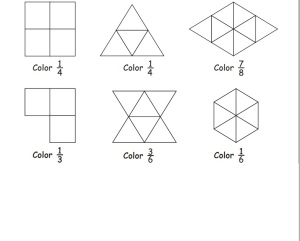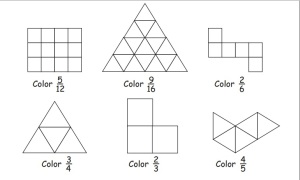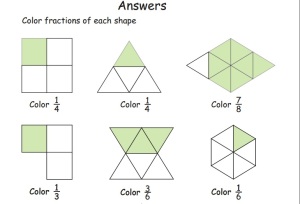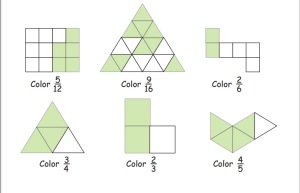

Math Lessons
Fractions
Week ( March 31st – April 4th)
Fractions Review
Adequateness: http://www.ixl.com/math/grade-5/fractions-review
Students divided in groups are going to solve mathematical operations related with Addition of fractions with like denominators and unlike denominators.
Adding Fractions with unlike Denominators
To add fractions with unlike denominators, first rewrite the fraction with the same denominators. To do this, find the least comon denominator, which is also the lowest common multiple of the two denominators.
For Example: to add 1/5+2/3, rewrite the fractions with the lowest common multiple of 3 and 5, 15 as the denominator.
Since 1/5= 3/15 and 2/3 =10/15, the sum can be rewritten as:
3/15 + 10/15
Now that the fractions have a common denominator, the denominatr stays the same and the numerators are added.
3/15 + 10/15 = 13/15.
—————————————————————————————————————————————————
Improper Fractions
http://www.mathsisfun.com/improper-fractions.html
  |
An Improper fraction has a top number larger than (or equal to) the bottom number, It is “top-heavy“ |
|
|
||
| (seven-fourths or seven-quarters) |
More Examples
| 3 | 7 | 16 | 15 | 99 | ||||
| 2 | 3 | 15 | 15 | 5 |
See how the top number is bigger than (or equal to) the bottom number?
That makes it an Improper Fraction, (but there is nothing wrong about Improper Fractions).
Three Types of Fractions
There are three types of fraction:

Fractions
A Fraction (such as 7/4) has two numbers:
| Numerator |
| Denominator |
The top number is the Numerator, it is the number of parts you have.
The bottom number is the Denominator, it is the number of parts the whole is divided into.
Example: 7/4 means:
- We have 7 parts
- Each part is a quarter (1/4) of a whole
So we can define the three types of fractions like this:
| Proper Fractions: | The numerator is less than the denominator |
|---|---|
| Examples: 1/3, 3/4, 2/7 | |
| Improper Fractions: | The numerator is greater than (or equal to) the denominator |
| Examples: 4/3, 11/4, 7/7 | |
| Mixed Fractions: | A whole number and proper fraction together |
| Examples: 1 1/3, 2 1/4, 16 2/5 |
Improper Fraction
So, an improper fraction is just a fraction where the top number (numerator) is greater than or equal to the bottom number (denominator).
In other words, it is top-heavy.
 4/4 |
Can be EqualWhat about when the numerator is equal to the denominator? For example 4/4 ? Well, it is obviously the same as a whole, but it is written as a fraction, so most people agree it is a type of improper fraction. |
Improper Fractions or Mixed Fractions
You can use either an improper fraction or a mixed fraction to show the same amount. For example 1 3/4 = 7/4, shown here:
| 1 3/4 | 7/4 | |
  |
= |   |
Converting Improper Fractions to Mixed Fractions
To convert an improper fraction to a mixed fraction, follow these steps:
|
|
Example: Convert 11/4 to a mixed fraction.
Divide:
Write down the 2 and then write down the remainder (3) above the denominator (4), like this:
| 2 | 3 |
| 4 |
Converting Mixed Fractions to Improper Fractions
To convert a mixed fraction to an improper fraction, follow these steps:
|
|
Example: Convert 3 2/5 to an improper fraction.
Multiply the whole number by the denominator:
Add the numerator to that:
Then write that down above the denominator, like this:
| 17 |
| 5 |
Are Improper Fractions Bad ?
NO, they aren’t bad!
For mathematics they are actually better than mixed fractions. Because mixed fractions can be confusing when you write them down in a formula (are the two parts supposed to be added or multiplied?):
| Mixed Fraction: | What is: | 1 + 2 1/4 | ? | |
|---|---|---|---|---|
| Is it: | 1 + 2 + 1/4 | = 3 1/4 ? | ||
| Or is it: | 1 + 2 × 1/4 | = 1 1/2 ? | ||
| Improper Fraction: | What is: | 1 + 9/4 | ? | |
| It is: | 4/4 + 9/4 = 13/4 |
But, for everyday use, people understand mixed fractions better.
Example: It is easier to say “I ate 2 1/4 sausages”, than “I ate 9/4 sausages”
INTERACTIVE LEARNING
Where in everyday life have you seen two or more fractions with unlike denominators?
Problem:
Over the weekend, Eleni ate 1/4 box of cereal and Freddie ate 3/8 box of the same box of cereal. What portion of the box of cereal did they eat in all?
Simplifying Fractions
Part of a whole.
· the bottom number (the denominator) says how many parts the whole is divided into
· the top number (the numerator) says how many you have.
1/2 (One Half)

1/4 (One Quarter)

3/8 (Three eighths(
https://www.youtube.com/watch?v=bFosWzDPALg
Textbook page 220
Fractions
Name: ________________________ Class: ___________
Color fractions of each shape
http://www.mathplayground.com/fractions_add.html

 Division Warm up: http://www.amblesideprimary.com/ambleweb/mentalmaths/dividermachine.html Learn Division with 2 Digits https://www.youtube.com/watch?v=eIUoIhfupuA Division parts name
Division Warm up: http://www.amblesideprimary.com/ambleweb/mentalmaths/dividermachine.html Learn Division with 2 Digits https://www.youtube.com/watch?v=eIUoIhfupuA Division parts name
Divisor: is the number used to divide another number. Dividend: is the number you start out with before you divide. The dividend is the number that gets divided by another number.

Quotient: The number other than the remainder that is the result of dividing.
Remainder: The number less than the divisor that remains after the division is complete.
Vocabulary
- Dividend
- Divisor
- Quotient
- Remainder
Practice: Ex:

Adequatness: Abdul, Soraya, Rafat, Adel.
next resource> http://www.ixl.com/math/grade-5 http://www.dadsworksheets.com/v1/Worksheets/Long%20Division/Two_Digit_Divisor_Division_With_Remainders_V4.html







